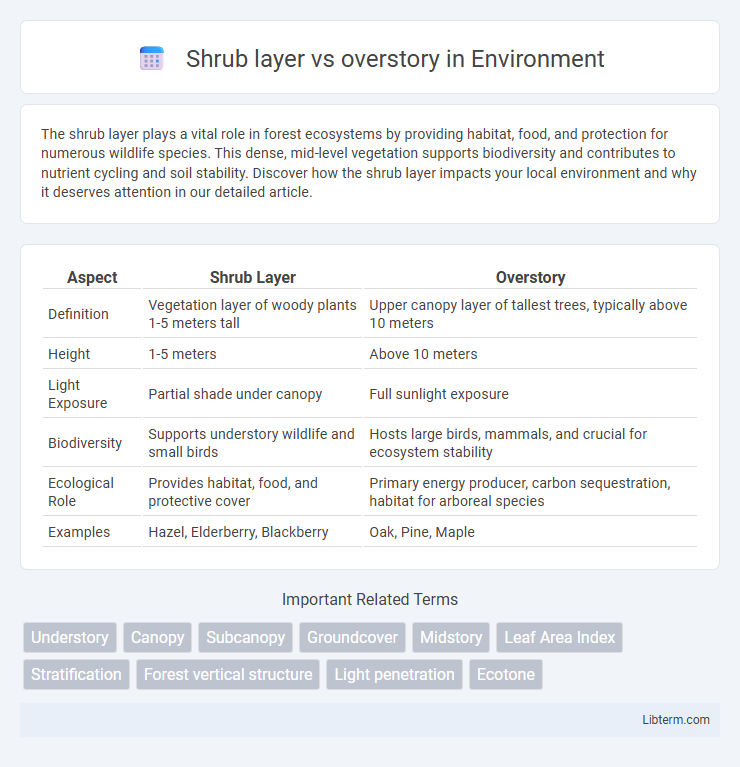The shrub layer plays a vital role in forest ecosystems by providing habitat, food, and protection for numerous wildlife species. This dense, mid-level vegetation supports biodiversity and contributes to nutrient cycling and soil stability. Discover how the shrub layer impacts your local environment and why it deserves attention in our detailed article.
Table of Comparison
| Aspect | Shrub Layer | Overstory |
|---|---|---|
| Definition | Vegetation layer of woody plants 1-5 meters tall | Upper canopy layer of tallest trees, typically above 10 meters |
| Height | 1-5 meters | Above 10 meters |
| Light Exposure | Partial shade under canopy | Full sunlight exposure |
| Biodiversity | Supports understory wildlife and small birds | Hosts large birds, mammals, and crucial for ecosystem stability |
| Ecological Role | Provides habitat, food, and protective cover | Primary energy producer, carbon sequestration, habitat for arboreal species |
| Examples | Hazel, Elderberry, Blackberry | Oak, Pine, Maple |
Introduction to Forest Layers
The shrub layer consists of woody plants and small trees that grow beneath the taller overstory, playing a vital role in forest biodiversity and habitat complexity. The overstory, or canopy layer, comprises the tallest trees that form a continuous cover, regulating light penetration and microclimate within the forest. Understanding the distinct functions and interactions between the shrub layer and overstory is essential for studying forest structure and ecosystem dynamics.
Defining the Shrub Layer
The shrub layer is defined as the stratum of vegetation consisting primarily of woody plants that are shorter than the overstory trees, typically ranging from 1 to 5 meters in height. It plays a critical role in forest ecosystems by providing habitat, food resources, and microclimatic regulation beneath the taller canopy formed by the overstory. Unlike the overstory, which includes mature trees forming the uppermost canopy layer and receiving the most sunlight, the shrub layer occupies the intermediate vertical space, influencing biodiversity and forest structure.
Understanding the Overstory
The overstory consists of the tallest trees forming the forest canopy, playing a crucial role in regulating light availability and microclimate for the underlying shrub layer. This upper layer influences ecological processes such as photosynthesis rates, habitat structure, and nutrient cycling by controlling sunlight penetration and rainfall interception. Understanding the overstory's composition and density helps predict understory vegetation patterns and overall forest ecosystem health.
Key Differences Between Shrub Layer and Overstory
The shrub layer consists of woody plants typically ranging from 1 to 5 meters in height, occupying the mid-level vegetation beneath the forest canopy, while the overstory is composed of the tallest trees forming the uppermost canopy layer, often exceeding 20 meters in height. Key differences include structural function, with the overstory providing primary canopy cover that regulates light and microclimate, whereas the shrub layer contributes to understory biodiversity and habitat complexity. Ecologically, the overstory plays a dominant role in energy capture and carbon storage, while the shrub layer supports regeneration and offers food and shelter for various wildlife species.
Plant Species Found in the Shrub Layer
The shrub layer, located beneath the overstory canopy, hosts diverse plant species such as azaleas, rhododendrons, mountain laurels, and various berry-producing bushes like blueberries and huckleberries. These species thrive in the filtered sunlight and contribute to the forest's biodiversity by providing food and habitat for wildlife. Unlike the taller overstory trees, shrubs in this layer play a critical role in nutrient cycling and understory vegetation dynamics.
Flora Dominating the Overstory
The overstory is dominated by tall, mature trees such as oaks (Quercus spp.), maples (Acer spp.), and pines (Pinus spp.), which form the upper canopy layer and play a critical role in regulating light availability and microclimate conditions. In contrast, the shrub layer consists of smaller woody plants like dogwood (Cornus spp.), azalea (Rhododendron spp.), and holly (Ilex spp.), which thrive under the filtered light beneath the overstory canopy. Overstory flora influence forest structure, nutrient cycling, and habitat complexity more significantly than the shrub layer due to their size and dominance in biomass.
Ecological Roles of the Shrub Layer
The shrub layer plays a vital ecological role by providing habitat and food resources for numerous wildlife species, including birds, insects, and small mammals. It contributes to nutrient cycling and soil stabilization through its dense root systems, enhancing forest ecosystem resilience. Unlike the overstory, which primarily influences microclimate and light availability, the shrub layer directly affects biodiversity and understory dynamics in forest environments.
Overstory’s Impact on Forest Ecosystem
The overstory, comprised of the tallest trees, plays a crucial role in regulating light penetration, temperature, and moisture levels within the forest ecosystem, directly influencing the growth and biodiversity of the shrub layer beneath. Overstory trees facilitate nutrient cycling through leaf litter and provide habitat for a variety of wildlife, enhancing ecosystem complexity and resilience. Their canopy structure shapes microclimates, affecting seedling survival and the overall forest regeneration process.
Biodiversity Comparison: Shrub Layer vs Overstory
The shrub layer supports higher biodiversity by offering diverse microhabitats and food sources for various insects, birds, and small mammals, contributing significantly to ecosystem complexity. In contrast, the overstory provides structural stability and shade, hosting specialized species adapted to canopy environments but generally supporting lower species richness. The interaction between shrub layer and overstory enhances vertical habitat stratification, which is crucial for maintaining overall forest biodiversity.
Conservation and Management Practices
Conservation and management practices in forest ecosystems emphasize maintaining the structural balance between the shrub layer and overstory to support biodiversity and resilience. Effective strategies include selective thinning of the overstory to enhance light penetration, promoting shrub layer growth essential for wildlife habitat and understorey regeneration. Protecting the shrub layer during logging operations prevents soil erosion and preserves nutrient cycling critical for sustaining forest health.
Shrub layer Infographic

 libterm.com
libterm.com